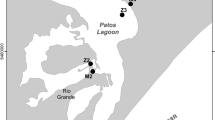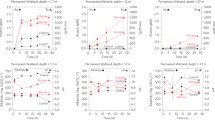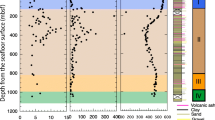Abstract
Arsenic is a wide-spread contaminant of soils and sediments, andmany watersheds worldwide regularly experience severe arsenic loading. While the toxicityof arsenic to plants and animals is well recognized, the geochemical and biological transformationsthat alter its bioavailability in the environment are multifaceted and remain poorly understood.This communication provides a brief overview of our current understanding of the biogeochemistryof arsenic in circumneutral freshwater sediments, placing special emphasis on microbialtransformations. Arsenic can reside in a number of oxidation states and complex ions. The commoninorganic aqueous species at circumneutral pH are the negatively charged arsenates(H2AsVO4 - and HasVO4 2-) and zero-charged arsenite(H3AsIIIO3 0). Arsenic undergoes diagenesis in response to both physicaland biogeochemical processes. It accumulates in oxic sediments by adsorption on and/orco-precipitation with hydrous iron and manganese oxides. Burial of such sediments in anoxic/suboxicenvironments favors their reduction, releasing Fe(II), Mn(II) and associatedadsorbed/coprecipitated As. Upward advection can translocate these cations and As into theoverlying oxic zone where they may reprecipitate. Alternatively, As may be repartitioned tothe sulfidic phase, forming precipitates such as arsenopyrite and orpiment. Soluble and adsorbedAs species undergo biotic transformations. As(V) can serve as the terminal electronacceptor in the biological oxidation of organic matter, and the limited number of microbes capableof this transformations are diverse in their phylogeny and physiology. Fe(III)-respiring bacteriacan mobilize both As(V) and As(III) bound to ferric oxides by the reductive dissolution ofiron-arsenate minerals. SO4 2--reducing bacteria canpromote deposition of As(III) as sulfide minerals via their production of sulfide. A limited number of As(III)-oxidizing bacteriahave been identified, some of which couple this reaction to growth. Lastly, prokaryotic andeukaryotic microbes can alter arsenic toxicity either by coupling cellular export to its reductionor by converting inorganic As to organo-arsenical compounds. The degree to which each ofthese metabolic transformations influences As mobilization or sequestration in differentsedimentary matrices remains to be established.
Similar content being viewed by others
References
Aggett J & O'Brien GA (1985) Detailed model for the mobility of arsenic in lacustrine sediments based on measurements in Lake Ohakuri. Environ. Sci. Technol. 19: 231–238
Ahmann D, Krumholz LR, Hemond HF, Lovley DR & Morel FMM (1997) Microbial mobilization of arsenic from sediments of the Aberjona watershed. Environ. Sci. Technol. 31: 2923–2930
Ahmann D, Roberts AL, Krumholz LR & Morel FMM (1994) Microbe grows by reducing arsenic. Nature 371: 750
Anderson LCD & Bruland KW (1991) Biogeochemistry of arsenic in natural waters: The importance of methylated species. Environ. Sci. Technol. 25: 420–427
Andreae MO(1978) Distribution and speciation of arsenic in natural waters and some marine algae. Deep-Sea Res. 25: 391–402
Balzer W (1982) On the distribution of iron and manganese at the sediment/water interface: thermodynamic versus kinetic control. Geochim. Cosmochim. Acta 46: 1153–1161
Belzile N & Tessier A (1990) Interactions between arsenic and iron oxyhydroxides in lacustrine sediments. Geochim. Cosmochim. Acta 54: 103–109
Bhumbla DK & Keefer RF (1994) Arsenic mobilization and bioavailability in soils. In Nriagu JO (ed) Arsenic in the Environment, Part I: Cycling and Characterization (pp 51–82). Wiley & Sons, Inc., New York
Blum JS, Bindi AB, Buzzelli J, Stolz JF & Oremland RS (1998) Bacillus arsenicoselenatis, sp. nov., and Bacillus selenitireducens, sp. nov.: two haloalkaliphiles from Mono Lake, California that respires oxyanions of selenium and arsenic. Arch. Micobiol. 171: 19–30
Boyle RW & Jonasson IR (1973) The geochemistry of arsenic and its use as an indicator element for geochemical prospecting. J. Geochem. Explor. 2: 252–296
British Geological Survey (2001) In Kinniburgh DG & Smedley PL (eds) Arsenic Contamination of Groundwater in Bangladesh. Vol. 1: Summary. BGS Report WC/00/19
Byron WR, Bierbower GW, Brouwer JB & Hansen WH (1967) Pathologic changes in rats and dogs from two-year feeding of sodium arsenite or sodium arsenate. Toxicol. Appl. Pharmacol. 10: 132–147
Castro JM, Wielinga BW, Gannon JE & Moore JN (1999) Stimulation of sulfate-reducing bacteria in lake water from a former open-pit mine through addition of organic wastes. Wat. Env. Res. 71: 218–223
Cherry JA, Shaikh AU, Tallman DE & Nicholson RV (1979) Arsenic species as an indictor of redox conditions in groundwater. J. Hydrol. 43: 373–392
Chilvers DC & Peterson PJ (1987) Global cycling of arsenic. In Hutchinson TC & Meema KM (ed) Lead, Mercury, Cadmium and Arsenic in the Environment (pp 279–301). Wiley & Sons, New York
Colbourn P, Alloway BJ & Thornton I (1975) Arsenic and heavy metals in soils associated with regional geochemical anomalies in south-west England. Sci. Total Environ. 4: 359–363
Cullen WR & Reimer KJ (1989) Arsenic speciation in the environment. Chem. Rev. 89: 713–764
Cummings DE, Caccavo F, Fendorf S & Rosenzweig RF (1999) Arsenic mobilization by the dissimilatory Fe(III)-reducing bacterium Shewanella alga. BrY. Environ. Sci. Technol. 33: 723–729
Cummings DE, Spring S & Rosenzweig SF (2001) The ecology of iron-reducing bacteria in pristine and contaminated environments. In Hurst CJ, Crawford RL, Knudsen GR, McInerney MJ & Stetzenbach LD (eds) Manual of Environmental Microbiology (pp 1018–1027). 2nd edn. ASM Press, Washington, D.C
Davis JA (1984) Complexation of trace metals by adsorbed natural organic matter. Geochim. Cosmochim. Acta 48: 679–691
DeVitre R, Belzile N & Tessier A (1991) Speciation and adsorption of arsenic on diagenetic iron oxyhydroxides. Limnol. Oceanogr. 36: 1480–1485
Dowdle PR, Laverman AM & Oremland RS (1996) Bacterial dissimilatory reduction of arsenic(V) to arsenic(III) in anoxic sediments. Appl. Env. Microbiol. 62: 1664–1669
Dvorak DH, Hedin RS, Edenborn HM & McIntire PE (1992) Treatment of metal-contaminated water using bacterial sulfate reduction: Results from pilot-scale reactors. Biotechnol. Bioeng. 40: 609–616
Fenchel T & Finlay BJ (1995) Ecology and Evolution in Anoxic Worlds. Oxford University Press, Oxford
Fendorf S, Eick MJ, Grossl P & Sparks DL (1997) Arsenate and chromate retention mechanisms on goethite. Environ. Sci. Technol. 31: 315–320
Ferguson JF & Gavis J (1972) A review of the arsenic cycle in natural waters. Wat. Res. 6: 1259–1274
Frost RR & Griffin RA (1977) Effect of pH and adsorption of arsenic and selenium from landfill leachate by clay minerals. Soil Sci. Soc. Am. J. 41: 53–57
Gihring TM & Banfield JF (2001) Arsenite oxidation and arsenate respiration by a new Thermus isolate. FEMS Microbiol. Lett. 204: 335–340
Goldhaber MB & Kaplan IR (1974) The sulfur cycle. In Goldberg ED (ed.), The Sea, Vol. 5 (pp 569–655). Wiley & Sons, New York
Green HH (1918) Description of a bacterium which oxidizes arsenite to arsenate, and of one which reduces arsenate to arsenite, isolated from a cattle-dipping tank. S. Afr. J. Sci. 14: 465–467
Harrington JM, Fendorf SE & Rosenzweig RF (1998a) Biotic generation of arsenic(III) in metal(loid)-contaminated freshwater lake sediments. Environ. Sci. Technol. 32: 2425–2430
Hasegawa H (1997) The behavior of trivalent and pebtavalent methylarsenicals in Lake Biwa. Appl. Organomet. Chem. 11: 305–311
Hasegawa H, Sohrin Y, Seki K, Sato M, Norisuye K, Naito K & Matsui M (2001) Biosynthesis and release of methylarsenic compounds during the growth of freshwater algae. Chemosphere 43: 265–272
Harrington JM, LaForce MJ, Rember WC, Fendorf SE & Rosenzweig RF (1998b) Phase associations and mobilization of iron and trace elements in Coeur d'Alene Lake, Idaho. Env. Sci. Technol. 32: 650–666
Heywood R & Sortwell RJ (1979) Arsenic intoxication in the rhesus monkey. Toxicol. Lett. 3: 137–144
Huber R, Sacher M, Vollmann A, Huber H & Rose D (2000) Respiration of arsenate and selenate by hyperthermophilic Archaea. System Appl. Microbiol. 23: 305–314
Ilyaletdinov AN & Abdrashitova SA (1981) Autotrophic oxidation of arsenic by a culture of Psuedomonas arsenitoxidans. Mikrobiologiya 50: 197–204
Jain A. Raven KP & Loeppert RH (1998) Arsenite and arsenate adsorption on ferrihydrite: Surface charge reduction and net OH-release stoichiometry. Environ. Sci. Technol. 33: 1179–1184
Jones CA, Langner HW, Anderson K, McDermott TR & Inskeep WP (2000) Rates of microbially mediated arsenate reduction and solubilization. Soil Sci. Soc. Am. J. 64: 600–608
Kieft TL, Fredrickson JK, Onstott TC, Corby YA, Kostandarithes HM, Bailey TJ, Kennedy DW, Li SW, Plymale AE, Spadoni CM & Gray MS (1999) Dissimilatory reduction of Fe(III) and other electron acceptors by a Thermus isolate. Appl. Environ. Microbiol. 65: 1214–1221
Krafft T & Macy JM (1998) Purification and characterization of the respiratory arsenate reductase of Chrysiogenes arsenatis. Eur. J. Biochem. 255: 647–653
Kuhn A & Sigg L (1993) Arsenic cycling in eutrophic Lake Greifen, Switzerland: Influence of seasonal redox processes. Limnol. Oceanogr. 38: 1052–1059
Langer HW, Jackson CR, McDermott TR & Inskeep WP (2001) Rapid oxidation of arsenite in a hot spring ecosystem, Yellowstone National Park. Environ. Sci. Technol. 35: 3302–3309
Laverman AM, Blum JS, Schaefer JK, Phillips EJP, Lovley DR & Oremland RS (1995) Growth of strain SES-3 with arsenate and other diverse electron acceptors. Appl. Env.Microbiol. 61: 3556–3564
Leu JY, McGovern-Traa CP, Porter AJ & Hamilton WA (1999) The same species of sulfate-reducing Desulfomicrobium occur in different oil field environments in the North Sea. Lett. Appl. Microbiol. 4: 246–252
Levander OA (ed.) (1975) Arsenic. National Academy of Sciences, Washington, D.C
Lonergan DJ, Jenter HL, Coates JD, Phillips EJ, Schmidt TM & Lovley DR (1996) Phylogenetic analysis of dissimilatory Fe(III)-reducing bacteria. J. Bacteriol. 178: 2402–2408
Lovley DR (2000) Fe(III) and Mn(IV) reduction. In Lovley DR (ed) Environmental Microbe-Metal Interactions (pp 3–30). ASM Press, Washington, D.C
Lovley DR, Coates JD, Saffarini D & Lonergan JD (1997) Diversity of dissimilatory Fe(III)-reducing bacteria. In Winkelman G & Carrano CJ (ed) Iron and Related Transition Metals in Microbial Metabolism (pp 187–215). Hardwood Academic Publishers, Amsterdam, The Netherlands
Mackenzie FT, Lantzy RJ & Paterson V (1979) Global trace metal cycles and predictions. J. Int. Assoc. Math. Geol. 11: 99–142
Macy JM, Nunan K, Hagen KD, Dixon DR, Harbour PJ, Cahill M & Sly LI (1996) Chrysiogenes arsenatis gen. nov., sp. nov., a new arsenate-respiring bacterium isolated from gold mine wastewater. Int. J. Syst. Bacteriol. 46: 1153–1157
Macy JM, Santini JM, Pauling BV, O'Neill AH & Sly LI (2000) Two new arsenate/sulfate-reducing bacteria: Mechanisms of arsenate reduction. Arch. Microbiol. 173: 49–57
Manning BA & Goldberg S (1997) Adsorption and stability of arsenic(III) at the clay mineral-water interface. Environ. Sci. Technol. 31: 2005–2011
Manning BA, Fendorf SE & Goldberg S (1998) Surface structures and stability of arsenic(III) on goethite: Spectroscopic evidence for inner-sphere complexes. Environ. Sci. Technol. 32: 2383–2388
Martin P, DeMel S, Shi J, Gladysheva T, Gatti DL, Rosen BP, Edwards BFP (2001) Insights into the structure, solvation, and mechanism of ArsC arsenate reductase, a novel arsenic detoxification enzyme. Structure 9: 1071–1081
Masscheleyn PH, Delaune RD & Patrick WH Jr (1991) Effect of redox potential and pH on arsenic speciation and solubility in a contaminated soil. Environ. Sci. Technol. 25: 1414–1419
McKenzie RM (1981) The surface charge on manganese dioxides. Aust. J. Soil Technol. 19: 41–50
Mok WM & Wai CM (1994) Mobilization of arsenic in contaminated river waters. In Nriagu JO (ed) Arsenic in the Environment, Part I: Cycling and Characterization (pp 99–117). Wiley & Sons, Inc., New York
Moore JN, Ficklin WH & Johns C (1988) Partitioning of arsenic and metals in reducing sulfidic sediments. Environ. Sci. Technol. 22: 432–437
Moore JN, Walker JR & Hayes TH (1990) Reaction scheme for the oxidation of As(III) to As(V) by birnessite. Clays and Clay Minerals 38: 549–555
Morton WE & Dunnette DA (1994) Health effects of environmental arsenic. In Nriagu JO (ed) Arsenic in the Environment, Part II: Human Health and Ecosystem Effects (pp 17–34). Wiley & Sons, Inc., New York
Murray JW & Brewer PG (1977) Mechanisms of removal of manganese, iron and other trace metals from seawater. In Glasby GP (ed) Marine Manganese Deposits (pp 291–326). Elsevier Science, New York
National Research Council (1999) Arsenic in Drinking Water. National Academy Press, Washington, D.C
Newman DK, Ahmann D & Morel FMM (1998) A brief review of microbial arsenate respiration. Geomicrobiol. 15: 255–268
Newman DK & Banfield JF (2002) Geomicrobiology: How molecular-scale interactions underpin biogeochemical systems. Science 296: 1071–1077
Newman DK, Kennedy EK, Coates JD, Ahmann D, Ellis DJ, Lovley DR & Morel FMM (1997) Dissimilatory arsenate and sulfate reduction in Desulfotomaculum auripigmentum sp. nov. Arch. Microbiol. 168: 380–388
Newport PJ & Nedwell DB (1988) The mechanisms of inhibition of Desulfovibrio and Desulfotomaculum species by selenate and molybdate. J. Appl. Bacteriol. 65: 419–423
Nickson R, McArthur J, Burgess W, Ahmed KM, Ravenscroft P & Rahman M (1998) Arsenic poisoning of Bangladesh groundwater. Nature 395: 338
Niggemyer A, Spring S, Stackebrandt E & Rosenzweig RF (2001) Isolation and characterization of a novel As(V)-reducing bacterium: Implications for arsenic mobilization and the genus Desulfitobacterium. Appl. Environ. Microbiol. 67: 5568–5580
Nriagu JO & Pacyna JM (1988) Quantitative assessment of worldwide contamination of air, water, and soils by trace metals. Nature 333: 134–139
Oremland RS, Blum JS, Culbertson CW, Visscher PT, Miller LG, Dowdle P & Strohmaier FE (1994) Isolation, growth, and metabolism of an obligately anaerobic, selenate-respiring bacterium, SES-3. Appl. Env. Microbiol. 60: 3011–3019
Oremland RS & Stolz J (2000) Dissimilatory reduction of selenate and arsenate in nature. In Lovley D (ed) Environmental Microbe-Metal Interactions (pp 199–224). ASM Press, Washington, D.C
Oscarson DW, Huang PM, Defosse C & Herbillo A (1981a) Oxidative power of Mn(IV) and Fe(III) oxides with respect to As(III) in terrestrial and aquatic environments. Nature 291: 50–51
Oscarson DW, Huang PM & Liaw WK (1980) The oxidation of arsenite by aquatic sediments. J. Envir. Qual. 9: 700–703
Oscarson DW, Huang PM & Liaw WK (1981b) The role of manganese in the oxidation of arsenite by freshwaterlake sediments. Clays and Clay Minerals 29: 219–225
Oscarson DW, Huang PM, Liaw WK & Hammer UT (1983) Kinetics of oxidation of arsenite by various manganese dioxides. Soil Sci. Soc. Am. J. 47: 644–648
Pawlik-Skowronska B (2001) Phytochelatin production in freshwater algae Stigeoclonium in response to heavy metals contained in mining water; effects of some environmental factors. Aquat. Toxicol. 52: 241–249
Peterson ML & Carpenter R (1985) Arsenic distributions in porewaters and sediments of Puget Sound, Lake Washington, the Washington coast and Saanich Inlet, B.C. Geochem. Cosmochim. Acta. 50: 353–369
Pierce ML & Moore CB (1982) Adsorption of arsenite and arsenate on amorphous iron hydroxide. Water Res. 16: 1247–1253
Rittle KA, Drever JI & Colberg PJS (1995) Precipitation of arsenic during bacterial sulfate reduction. Geomicrobiol. J. 13: 1–11
Reysenbach AL & Shock E (2002) Merging genomes with geochemistry in hydrothermal ecosystems. Science 296: 1077–1082
Rosen BP (1999) Families of arsenic transporters. Trends Microbiol. 7: 207–212
Sadiq M (1990) Arsenic chemistry in marine environmnets: A comparison between theoretical and field observations. Marine Chem. 31: 285–297
Santini JM, Sly LI, Schnagl RD & Macy JM (2000) A new chemolithoautotrophic arsenite-oxidizing bacterium isolated from a gold mine: Phylogenetic, physiological, and preliminary biochemical studies. Appl. Env. Microbiol. 66: 92–97
Scott MJ & Morgan JJ (1990) Energetics and conservative properties of redox systems. In Bassett RL & Melchior DC (ed) Chemical Modeling in Aqueous Systems II (pp 368–378). American Chemical Society Symposium Series 416, Washington, D.C
Senn DB & Hemond HF (2002) Nitrate controls on iron and arsenic in an urban lake. Science 296: 2373–2376
Smedley PL & Kinniburgh DG (2002) A review of the source, behaviour and distribution of arsenic in natural waters. Appl. Geochem. 17: 517–568
Smith E, Naidu R & Alston AM (1998) Arsenic in the soil environment: A review. Adv. Agron. 64: 149–195
Sohrin Y, Masakazu M, Kawashima M, Hojo M. & Hasegawa H (1997) Arsenic biogeochemistry affected by eutrophication in Lake Biwa, Japan. Environ. Sci. Technol. 31: 2712–2720
Spliethoff HM (1995) Biotic and abiotic transformation of arsenic in the Upper Mystic Lake [M.S. thesis]. Massachusetts Institute of Technology, Cambridge, MA
Spliethoff HM, Mason RP & Hemond HE (1995) Interannual variability in the speciation and mobility of arsenic in a dimictic lake. Environ. Sci. Technol. 29: 2157–2161
Stolz JF, Ellis DJ, Blum JS, Ahmann D, Lovley DR & Oremland RS (1999) Sulfurospirillum barnesii sp. nov. and Sulfurospirillum arsenophilum sp. nov., new members of the Sulfurospirillum clade of the ε Proteobacteria. Int. J. Syst. Bacteriol. 49: 1177–1180
Stolz JF, Gugliuzza T, Blum JS, Oremland R & Murillo FM (1997) Differential cytochrome content and reductase activity in Geospirillum barnesii. Arch. Microbiol. 167: 1–5
Stolz JF & Oremland RS (1999) Bacterial respiration of arsenic and selenium. FEMS Micobiol. Rev. 23: 615–627
Sun X & Doner HE (1996) An investigation of arsenate and arsenite bonding structures on goethite by FTIR. Sol. Sci. 161: 865–872
Takematsu N (1979) Sorption of transition metals on manganese and iron oxides, and silicate minerals. J. Oceanogr. Soc. Jpn. 35: 36–42
Tessier A, Rapin F & Carignan R (1985) Trace metals in oxic lake sediments: Possible adsorption onto iron oxyhydroxides. Geochim. Cosmochim. Acta 49: 183–194
Volkl P, Huber R, Drobner E, Rachel R, Burggraf S, Trincone A & Stetter KO (1993) Pyrobaculum aerophilum sp. nov., a novel nitrate-reducing hyperthermophilic archaeum. Appl. Environ. Microbiol. 59: 2918–2926
Wilkie JA & Hering JG (1998) Rapid oxidation of geothermal arsenic( III) in streamwaters of the eastern Sierra Nevada. Environ. Sci. Technol. 32: 657–662
Willsky GR & Malamy MH (1980) Effect of arsenate on inorganic phosphate transport in Escherichia coli. J. Bacteriol. 144: 366–374
Woolfolk CA & Whiteley HR (1962) Reduction of inorganic compounds with molecular hydrogen by Micrococcus lactilyticus. J. Bacteriol. 84: 647–658
Yan-Chu H (1994) Arsenic distribution in soils. In Nriagu JO (ed) Arsenic in the Environment, Part I: Cycling and Characterization (pp 17–49). Wiley & Sons, Inc., New York
Zobrist J, Dowdle PR, David JA & Oremland RS (2000) Mobilization of arsenite by dissimilatory reduction of adsorbed arsenate. Environ. Sci. Technol. 34: 4747–4753
Author information
Authors and Affiliations
Rights and permissions
About this article
Cite this article
Nicholas, D.R., Ramamoorthy, S., Palace, V. et al. Biogeochemical transformations of arsenic in circumneutral freshwater sediments. Biodegradation 14, 123–137 (2003). https://doi.org/10.1023/A:1024031700533
Issue Date:
DOI: https://doi.org/10.1023/A:1024031700533




